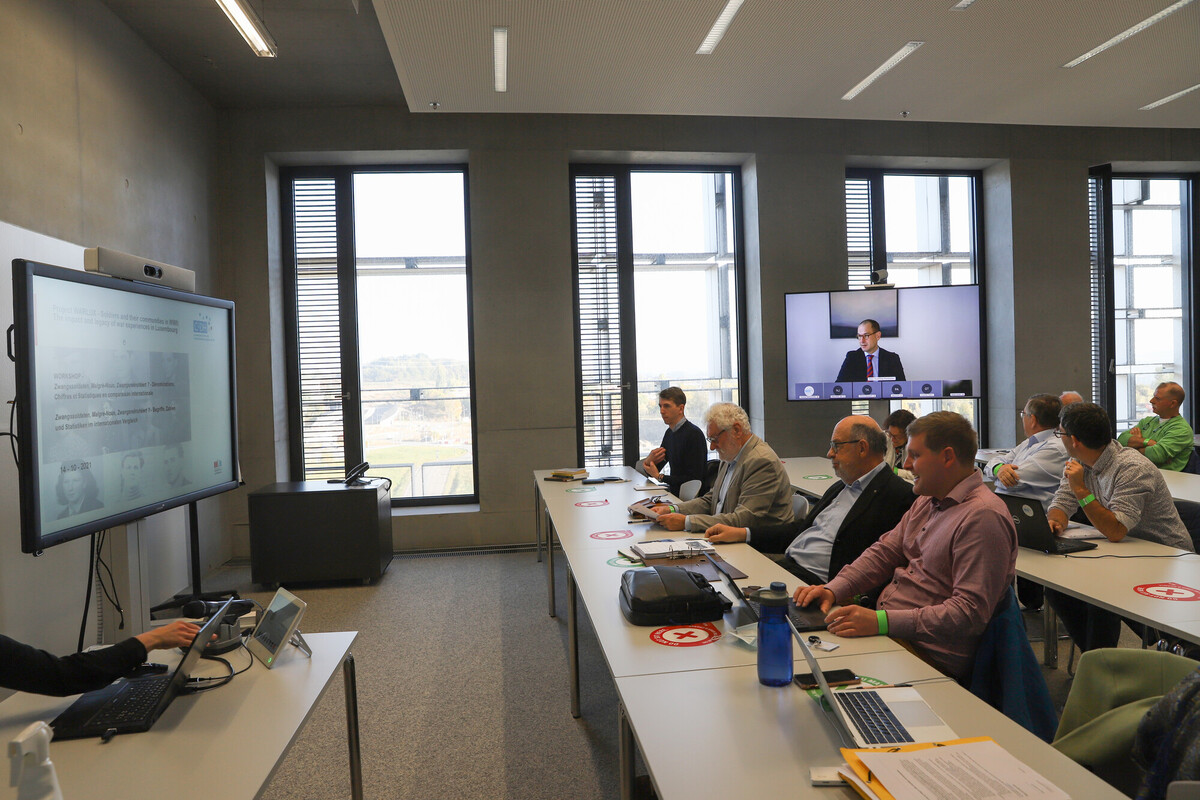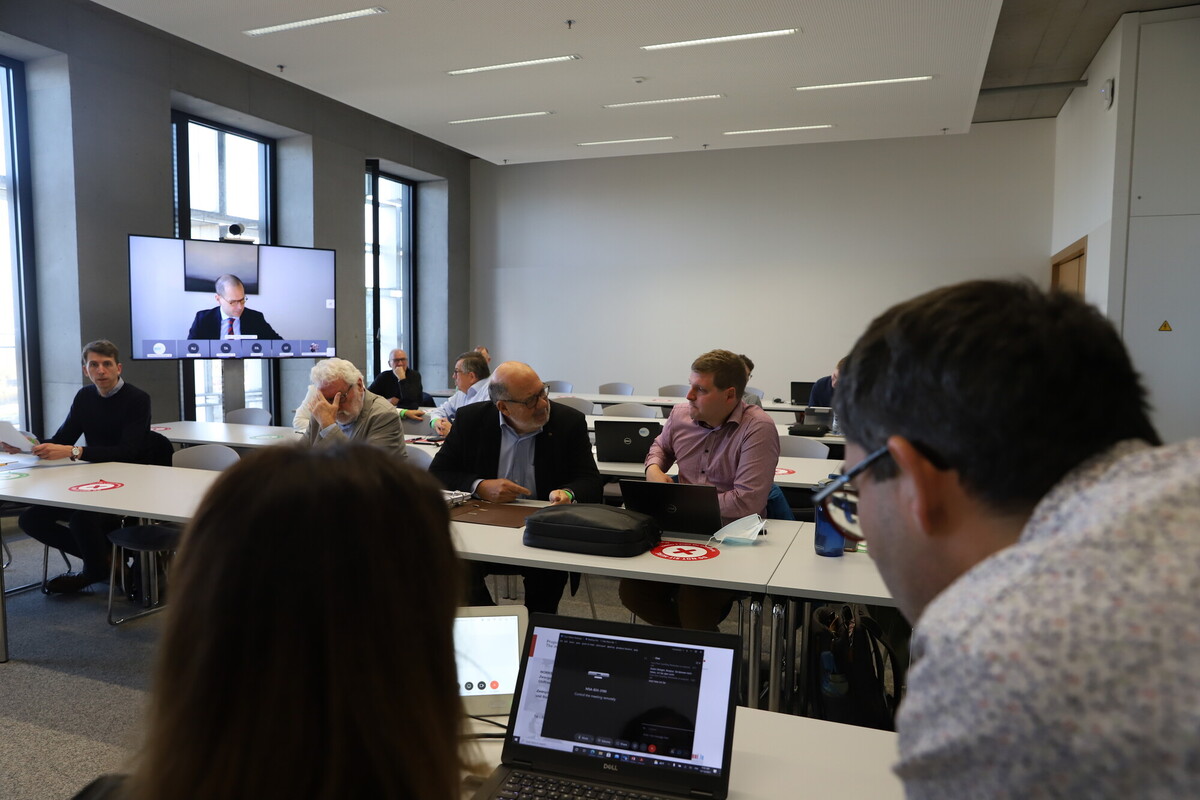The international workshop “Zwangssoldaten, Malgré-Nous, Zwansgsrekrutéiert? – Terms, Numbers and Statistics” brought together historians and non-historians from Belgium, France, Germany and Luxembourg to discuss the unlawful recruitment of non-German citizens to German labour services and the Wehrmacht in the occupied and de facto annexed territories of Eastern Belgium, the French Alsace-Moselle region and Luxembourg during the Second World War. Discussions during the workshop focused on differences in recruitment in these regions, existing research on the topic and areas still to be explored, as well as the terms used to describe the people affected and the numbers and statistics related to recruitment. The event was organised by the FNR-funded research team behind the project “WARLUX – Soldiers and their communities in WWII: The impact and legacy of war experiences in Luxembourg” and took place in a hybrid format at the University of Luxembourg on 14 October 2021.
Comparison of "Enrôlés de Force" in Luxembourg, Belgium and France
After a short welcome and introduction by NINA JANZ (University of Luxembourg), DENIS SCUTO (University of Luxembourg) opened the first panel. Frédéric Stroh (University of Strasbourg) was the first speaker with his presentation “Comparer les “incorporations de force”. Enjeux et implications” (“Comparing “forced recruitments”. Issues and implications”). He focused on the evolution of the historiography from 1995 onwards, with forced recruitment in the German-occupied territories during WWII now seen as an international phenomenon rather than a regional singularity. Although the former forced recruits from Belgium, France and Luxembourg have come together in associations/groups/veterans’ organisations/representations since the 1960s and their shared demands were published in 1965, we are still far from seeing a consensus about forced recruitment. Comparing the cases of countries in Western Europe to those in Eastern Europe (Czech Republic, Poland, Slovenia), it becomes clear that there is no general minimum definition of forced recruitment into German services in Europe in WWII.
Moreover, this is not the only problem: the language barrier hinders the exchange of research findings about the history of the recruitment of non-Germans in the various areas. Comparisons between the different people affected are already difficult because of issues with counting and different conditions surrounding naturalisation and the draft.
Instead of comparing completely different national historiographies, a new approach could be made towards a transnational comparison, incorporating the individual biographies and social backgrounds of the recruits.
CHRISTOPH BRÜLL (University of Luxembourg) presented “Les soldats de la Wehrmacht d’Eupen-Malmedy” (Soldiers from Eupen-Malmedy in the Wehrmacht), exploring the situation of forced enrolment in Eastern Belgium in WWII. The former German territories of Eupen and Malmedy, ceded to Belgium in 1920, were annexed on 18 May 1941, followed on 23 May by another ten towns which had never been under German rule. The 80 000 inhabitants received German nationality on 23 September 1941. 8 700 men were drafted to German services – the source for this number remains unknown –, 700 of which were volunteers, and 3 200 to 3 400 died. Soldiers from Eupen-Malmedy are the most comparable to German soldiers in terms of decorations, promotions and desertion, but as yet no systematic studies on the war experiences of Belgian soldiers have been carried out. The return of war survivors from POW camps lasted until 1947, and this delayed their integration into local societies. In Belgium, they were placed in internment camps on arrival, where they awaited release or trial. The term “forced recruits” was introduced by the Belgian government to differentiate them from Walloon and Flemish volunteers in the Wehrmacht and the Waffen-SS. But the term implies that the Eastern Belgian draftees were victims and not soldiers of the Wehrmacht, and this prevents questions being asked about their behaviour at the front during the war. Although Belgium and Germany signed treaties in 1956 and 1960 worth 80 million Deutschmarks for Belgian victims of Nazism, Belgian forced draftees were not yet included in this group. It was only in 1962 and 1973 that additional treaties between Belgium and Germany were signed that granted 43.5 million Deutschmarks to the Belgian state in financial compensation for the group qualified as “victims of war”. In 1974, the Belgian Parliament officially granted the draftees of Eupen-Malmedy and the ten communes the status of forced recruits, ultimately paving the way for financial compensation, but the law on this was only passed in 1989, after many Eastern Belgian forced recruits had already died.

PETER QUADFLIEG (Hessian State Archives, Wiesbaden) presented the history of Luxembourgish forced recruits to German services. According to him, around 15 5001 Luxembourgers were drafted to the Wehrmacht and the Waffen-SS. He summarised German recruitment in Luxembourg in five points. First, the motivation behind the recruitment of Luxembourgers by the German authorities was mainly to integrate young male Luxembourgers into German society by military service. The fact that Luxembourgish recruits only made up 3% of German casualties in the Battle of Stalingrad and they did not even have the strength to form one division confirms that the recruitment of Luxembourgers was for political and not military reasons. Second, a higher desertion rate, widespread passive resistance and reluctant behaviour towards the German authorities can be observed among the Luxembourgish group. But not all infractions were political (they included reporting drunk for duty), and the decision to desert was a personal one which depended on each individual’s moral viewpoint. Third, the strike actions in 1942 led to harsher measures in the country and hindered the integration of the recruits in the Wehrmacht. Fourth, the defensive attitude against forced recruitment became the central argument underpinning Luxembourg’s national resistance movement. This gave rise to a common master narrative in the post-war period that imputed patriotic and heroic behaviour to every recruit. Fifth and finally, the four preceding points should lead us to consider the fact that most Luxembourgers went to war without enthusiasm but fulfilled their service as expected. They were even promoted and decorated for their performance. However, this group is lost in the discourse between volunteers and deserters. These different interpretations led to an exculpation of the majority of forced recruits and the refusal to address war crimes committed by or with the participation of Luxembourg recruits.
JEAN-NOËL GRANDHOMME (University of Lorraine) explored the history of soldiers from Alsace-Moselle in the Wehrmacht, the so-called Malgré-Nous (literally “against our will”). Unlike Luxembourg and Slovenia but like Eastern Belgium, Alsace-Moselle was German during WWI, and some men from the region who had fought for Germany in this conflict already considered themselves as forced recruits after WWI. During WWII, between August 1942 and September 1944, a total of 275 000 men either from Alsace and born between 1907 and 1927 or from Moselle and born between 1914 and 1927 were drafted into German military services. At the same time, 18 000 to 19 000 men from Alsace-Moselle fought in the French Army. It is estimated that up to 3 500 men from Alsace-Moselle volunteered to join German military services but these include “false volunteers”, men who anticipated their call to arms by volunteering so that they could choose their service branch, i.e. the Kriegsmarine or the Luftwaffe rather than the Heer or the Waffen-SS. How many Alsace-Moselle men were officers remains an unanswered question. Also, around 8 000 women from Alsace-Moselle had to serve in the Kriegshilfsdienst (KHD) or as Luftwaffenhelferin. In total, 52 000 of the forced recruits from Alsace-Moselle died in German uniform during the war, while only a few died in French uniform. After the war, the Malgré-Nous and the Malgré-Elles (female recruits from Alsace-Moselle) who were drafted into the Reichsarbeitsdienst (RAD) and KHD joined together and set up associations. As early as 1945, French forced recruits who died and went missing in German services received the honour Morts pour la France. However, their relationship with the rest of France remained difficult long after the war. In 2005, the Schirmeck Memorial opened, commemorating not only the Malgré-Nous but also the people from Alsace-Moselle in the Resistance and the Allied armies. And only in 2008 did President Nicolas Sarkozy declare in a speech in Colmar that French forced recruits from WWII are a part of French society.
In the subsequent discussion, the participants discussed the official recognition of forced recruits in their home countries after the war: was this group recognised as either victims of Nazism or victims of a war crime? A further debate followed on whether or not one can speak of deportation in the case of forced recruits.
The Luxembourg Case - Parliamentary, Legal and Social Debates on the Conscription of Luxembourgers into the Wehrmacht and the Reich Labour Service
The second session was moderated by PAUL DOSTERT (Grand Ducal Institute). The first presentation in this session was given by DENIS SCUTO, who summarised the terminology, debates and arguments about Luxembourgish forced recruits in political discussions in parliament in the post-war period. SCUTO focused on political debates around the compensation law in 1948, in which the forced recruits were to be included. In parliament at the time, resistance fighters had organised themselves into a new political party, which had won a lot of votes during the 1945 elections and was thus represented – one might even say overrepresented – in parliament. The former forced recruits had also organised themselves into interest groups to speak with one voice, in the hopes of seeing their demands satisfied. To appear as one group, the forced recruits had to form a united front between objectors, deserters and those who fought the entire time without deserting. The term “forced recruits” was barely used at all in the debates in parliament; the Luxembourgish term “Ons Jongen” (“Our Boys”) was preferred to refer to the group of young Luxembourgish men who were forcibly drafted into German military services. Some politicians would even call them “non-volunteers”; others only mentioned those who had fallen on the battlefields. Very few politicians also mentioned the young Luxembourgish women forced into German labour services in this context. In the discussions the difference was made between volunteers and non-volunteers, and other groups of victims became increasingly marginalised since the forced recruits were by far the biggest group of victims in terms of numbers. The question for the former forced recruits at this point was whether they would manage to integrate themselves into the resistance narrative of heroes. The organisation “Ligue Ons Jongen” tried to do so by portraying recruited Luxembourgish men as potential resistance fighters who had been drafted by the German authorities to avoid the further growth of the Luxembourgish resistance. But in the end they described themselves as deportees, as victims of Nazism, and they were officially recognised as such in the 1960s. Because of a lack of funding after the war, the compensation law, in which the forced recruits were finally included, only came into force in 1981. The law excluded victims who were not deported for patriotic reasons, primarily the Jews.
The presentation by MICHEL R. PAULY (University of Luxembourg) focused on the etymology and use of the term “forced recruits”. The term appeared rarely but at regular intervals in German and French in the Luxembourgish press before and during WWII, although it was never clearly defined by the press. After the liberation of Luxembourg, between 1944 and 1950, the term used by far the most in the press in Luxembourg to describe Luxembourgish “forced recruits” was “Ons Jongen”. The latter notion is an etymological representation of a national trauma which can be explained statistically: in 1945, every fifth household in Luxembourg contained one young man who was concerned by the draft into German services; in other words approximately 20% of the Luxembourgish population at the time had a son or a brother who was affected. These statistics exclude the young Luxembourg women who were recruited into German labour services and other close family members, which would push the percentage of the population with a close relative with that fate up to 40% or more. In Luxembourgish legislative texts, the only notion used to describe this demographic group was “enrôlés de force” (“forced recruits”), which later became a legal status, thereby replacing the notion “Ons Jongen”. But even today, the characteristics of a “forced recruit” are not properly defined by any legislative text.

EVA MARIA KLOS (University of Trier) focused on the self-designation of Luxembourgish “forced recruits” in the context of international networking among veteran organisations. In 1945, the term “Ons Jongen” was the most commonly used, although its exact origins remain unknown. Using this term emphasised the notion of sacrifice for the homeland, aligning with the master narrative of Luxembourg as a nation of heroes. The self-designation as “victims of National Socialism” appeared only during the 1960s, during the main period of Western European compensation payments, when Germany signed bilateral compensation treaties with 11 other European countries. In this context, the former Luxembourgish “forced recruits” tried to emphasise their victim status so that they would be included in the compensation arrangements. They wanted to equate themselves with other deportees. The drafting of Luxembourgers into German services was recognised as a war crime by the Nazis in which Luxembourgers became victims of asymmetric violence. Since they were recognised by Luxembourgish law as victims of Nazism, they reinterpreted their fate as victims rather than heroes. But ultimately they were not recognised in the German-Luxembourgish compensation treaty as victims; they were recognised as regular soldiers because the German authorities had given them German citizenship before recruiting them to make this action appear legal. Luxembourgish recruits were therefore included in the Bundesversorgungsgesetz (the German Federal War Victims Relief Act) instead. KLOS therefore concluded that in the 1960s, Luxembourgish forced recruits had a tendency towards self-designation as victims. The evolution from “Ons Jongen” towards “forced recruits” reflected an evolution from self-sacrificing heroes for the fatherland towards victims of asymmetric violence.
ERNY LAMBORELLE (Fédération des enrôlés de force) explained the circumstances surrounding the creation of the Luxembourg Fédération des enrôlés de force (FEDDEF) and the viewpoint of this federation. As someone born after the war, he feels directly affected by the traumas passed down by previous generations. The traumas caused by the war and the drafting of young Luxembourgers into German services weighed heavily on Luxembourg society. The notion “Ons Jongen” or “Ons Jongen a Meedercher” (“Our Boys and Girls”) appeared for the first time as early in 1941, when young Luxembourgish men and women were first required to serve in the Reichsarbeitsdienst. The first section of the FEDDEF was founded in Dudelange in December 1944 to maintain comradeship among those who had been forcibly enrolled. It was not long before up to 90 local sections had been created, and other associations appeared for people who had to serve together in German forces and labour services. But significant terms such as “deserter” and “objector” have still not been clearly defined. Today the FEDDEF faces the challenge of its continued existence, since all but one of its current members are descendants of “forced recruits” and traditions such as commemorative ceremonies are not enough to ensure that remembrance will continue. For the FEDDEF, terms like “Ons Jongen a Meedercher”, “Les Sacrifiés” and “victims of Nazism” are still important.
The Luxembourg case - Official figures and statistics
In the subsequent discussion, the participants explored the extent to which “forced recruitment” was recognised by international law at the time of WWII and why the behaviour of each “forced recruit” needs to be researched individually. Historians also need to remember that notions cannot be considered as simply right or wrong but need to be seen and understood in their historical context because writing history is not a value judgment. Also, “deportee” and “deportation” are notions with a value judgment and lack a clear definition, which is why it is not clear whether one should speak about deportation in the context of “forced recruitment”.
PETER QUADFLIEG chaired the third session. MICHEL R. PAULY presented numbers and statistics about the Luxembourgish “forced recruits”, as well as the case study about forced recruits from the municipality of Weiswampach. In a first step, national statistics were compiled on how many men were born in the 1920-1927 cohorts. In addition, figures were provided on how many men were actually drafted and how many refused, deserted, went missing or died in action. The statistics analysed for this part were statistics about Luxembourg during WWII published in the 1980s by STATEC, the National Institute for Statistics and Economic Studies in Luxembourg, and the numbers from the Livre d’Or about Luxembourgish victims of WWII published by the Ministry of the Interior. Comparing the numbers in these statistical publications led to the conclusion that the figures do not match, i.e. they are contradictory and probably not accurate. In the case study about the “forced recruits” from Weiswampach, including both men and women, the numbers were taken from the municipal records and compared to the numbers for Weiswampach in the Livre d’Or. This led to the conclusion that it is not clear how people were counted and what requirements they needed to meet to be included, and that this was probably never regulated from the start, which means that there is no way of knowing today whether any numbers that are extrapolated from statistics will be correct or not.
In the subsequent discussion, the participants asked why fewer women were recruited than men. The answers to this question were the following: first, married and/or pregnant women were not drafted, which caused a wedding boom; second, with farmers’ sons being drafted, daughters were more likely not to be drafted so they could stay at home and help with the farm; and third, other methods existed and were used to avoid being drafted into German labour services.

THIERRY GROSBOIS (University of Luxembourg – Robert Schuman Institute of European Affairs) spoke about “Le cadre multilatéral interallié des négociations soviéto-luxembourgeoises en vue de la libération des enrôlés de force 1942-1956” (“The inter-allied multilateral framework of the Soviet-Luxembourg negotiations in order to liberate forced recruits from 1942 to 1956”). Four main points were made: First, the statistics on “forced recruitment” based on the data from the Soviet side were not accurate for many reasons, e.g. the sheer number of German POWs and the death rate among them were too high and the triage between different nationals was therefore so complicated that it could not possibly have produced reliable figures. Second, the USSR did not have the logistics to provide German POWs with basic necessities, which resulted in a high death rate. Third, the limited memories of the post-war period tended to focus on Luxembourgish POWs in Soviet camps because most of them had been in Soviet camps and only some had been in other Allied camps. But there were also Luxembourgish POWs in British, US and French camps – although the survival rate was much higher in these camps than in Soviet camps. Lengthy negotiations, especially between Luxembourg and France and Luxembourg and the US, were necessary to liberate Luxembourgish POWs. The British were less reticent to let Luxembourgish POWs go. Fourth and finally, a multilateral approach was necessary to liberate Luxembourgish “forced recruits” from Soviet POW camps. It took an enormous diplomatic effort from Luxembourg and other nations, including Belgium and France, to make the USSR recognise the problem with keeping “forced recruits” in their camps. Also, the USSR made the release of Luxembourgish POWs conditional on the exchange of all Soviet citizens (POWs and forced labourers) in Luxembourg.
In the subsequent discussion, the workshop participants debated why French nationals were released earlier from Soviet POW camps than Luxembourgers, how French POWs in Soviet captivity could be released during the war to join the Free French Forces but not Luxembourgers, and how the fates of Luxembourgish POWs were linked to the Soviet-French post-war negotiations to liberate French POWs.
Current and future research on the Conscription of non-Germans
The closing statement was given by CHRISTOPH BRÜLL, who summarised by explaining that despite the gaps in research on the topic and the remaining open questions, there is nevertheless considerable knowledge about “forced recruits”. There is a need for a dialogue in the Luxembourgish and international context to advance research and broaden shared knowledge. Comparisons between the situations in the different countries will not be enough, but links should nevertheless be established between these situations. The loss of the generation affected by this period should make a different historiography possible, although the position of the “forced recruits” continues to be defended by their descendants. The call for general definitions cannot be answered because the comparability between any given cases depends on the definition of every single historian. There is still a gap in the research about experiences at the war front, which after the war were adjusted to the narrative in such a way that it is very difficult to reconstruct these experiences accurately today. Furthermore, the role and history of female recruits has been severely neglected. There are historiographical and research gaps in Luxembourg but they can yet be overcome. However, there is one major factor in Luxembourg which is hindering this research today, namely the 2018 Archives Act, which, despite its positive aspects, restricts historians from conducting research into the contemporary era. For example, the historical reappraisal of the history of WWII is not still not always possible today, because there is an imbalance in this act between the importance of the right to personal privacy and the democratic right to accumulate knowledge and reappraise the past.
Despite these issues with archival research, the WARLUX project is trying to uncover how people drafted into German services during WWII and their relatives at home really experienced this situation at the time by looking into private personal documents (e.g. letters, diaries, etc.) from WWII.
- 1. This approximate figure indicates how many men lived in Luxembourg during WWII who were born in 1920-1927 and were therefore eligible for conscription under German law. Like all other figures in this context, this figure is not likely to be correct, either because the sources of statistics are unknown or because the numbers are inaccurate owing to non-standardised counting procedures.




